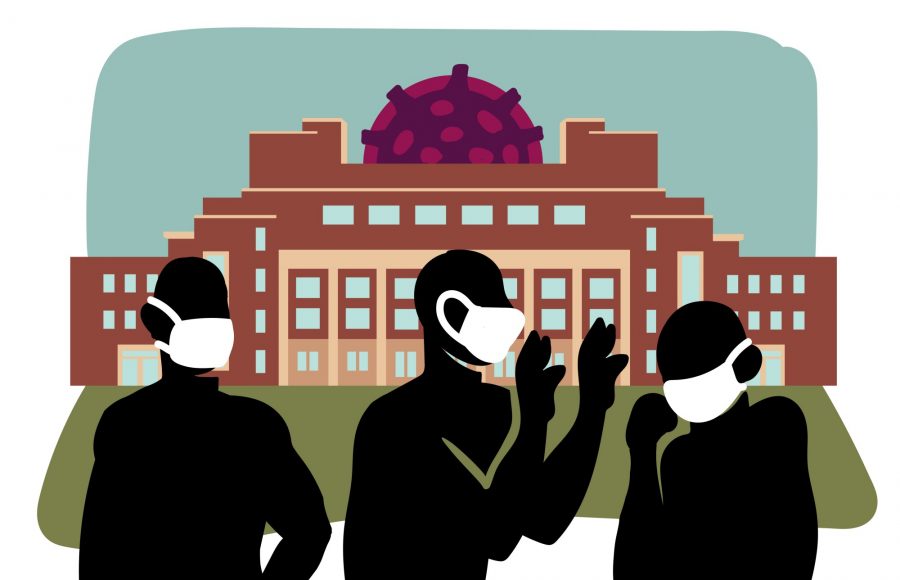Staff and faculty are responding to changes to the University of Minnesota’s COVID-19 policy, with most communicating unease about the lifting of masking requirements in some places on campus that took effect on March 21.
Although masks are still required in classrooms, public transportation and healthcare settings, staff and faculty said they are concerned about the change in mask requirements in office spaces and crowded public areas on campus. In a campus-wide email sent March 11 announcing the update, President Joan Gabel said this change is aligned with public health recommendations from the Minnesota Department of Health and the Centers for Disease Control and Prevention regarding masking.
The city of Minneapolis lifted its mask mandate on Feb. 24, and other universities in the area have eased restrictions as COVID-19 cases have recently declined.
“Individuals may continue to wear masks at any time and in any location, as a matter of personal protection,” Gabel said in the email. “We will continue to respect and honor the choices of all individuals who feel more comfortable wearing a mask.”
This is not the first time staff and faculty have voiced concern over the University’s COVID-19 response. In October 2021, University staff and faculty sent a formal resolution to administration requesting increased COVID-19 protocols, including stricter masking requirements.
“I’m disappointed,” said Ruth Shaw, an ecology, evolution and behavior professor. “I have not seen a clear rationale that justifies the changes … It puts many individuals and our broader community at a much greater risk than makes sense.”
Although Shaw said these changes do not pose a direct threat to her health because she can avoid areas where masks are no longer required, she added she is concerned for those who do not have that flexibility, like people who need to work and eat in dining halls.
“For my personal status I’m not very concerned, but I am concerned for many other individuals and for our community and of course, as our community incurs greater COVID, each one of us is individually at greater risk,” Shaw said.
Cherrene Horazuk, executive administrative and office specialist in the Humphrey School of Public Affairs and President of the UMN American Federation of State, County and Municipal Employees (AFSCME) Local 3800, said her greatest concern is about spaces open to the general public on campus and office spaces.
“We’ve heard from a lot of clerical workers and other technical workers and other support staff that are part of AFSCME who have real concerns about the way that the [masking] rules are laid out,” Horazuk said. “There are clear protections in place within the classroom setting but not within office settings or public spaces.”
Amanda Greenhart is a principal office and administrative specialist and AFSCME local 3800 Treasurer who works in a clinic on campus. She said having masks required in some indoor areas, but not others on campus has been confusing.
“We still get lots of people coming through without masks and then I have to say, ‘Hi, can I get you a mask?’” Greenhart said. “People do not like that.”
Some staff and faculty said they are satisfied with how the University has communicated the decision making process that led up to this announcement, while others said they are not.
“I think that it’s a failure of leadership when we don’t just say ‘this is the rule and we’re all going to do it,’” Greenhart said. “When we say ‘Oh, if you feel comfortable, then you do it,’ it’s not as effective.”
Sumanth Gopinath, associate professor of music theory, said he hoped to see a more cautious approach to protect vulnerable members of the campus community. Gopinath is on sabbatical leave this year, but has been on campus throughout the pandemic and will return in the fall.
“It just seems like masking is a relatively easy thing for most people to do and I’m glad that they’re keeping it in classrooms,” Gopinath said.
Gopinath said he believes it would have been more logical to continue requiring masks in all areas until the end of the semester.
Cynthia Lee, an executive administrative and office specialist and chair of the local 3800 AFSCME Health and Safety Committee, said in an email she believes masking and distancing is still the most effective way to control the spread of COVID-19 on campus.
Lee also said she is concerned the new BA.2 Omicron variant may spread with the more relaxed masking requirements in place.
“You can’t put the science aside,” Lee said. “That’s why this public health crisis keeps dragging on … with more [people] stuck with lifelong health issues from long COVID, and post-COVID.”
Since the University’s campus is open to the general public, loosening mask requirements could pose a greater risk, Horazuk said.
“To think that we can be safe, without there being more rigorous masking protocols, I think doesn’t take into account the reality that we’re in a large urban environment,” Horazuk said. “It is not walled off. The University is part of a much bigger community with a lot of people on campus for various reasons, and that’s concerning to people.”


















